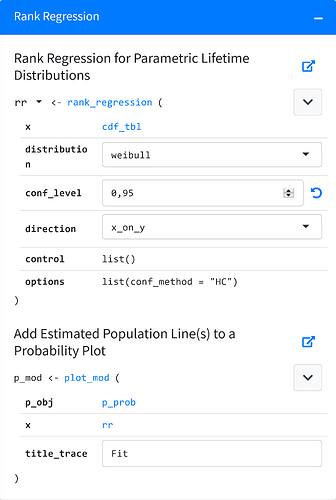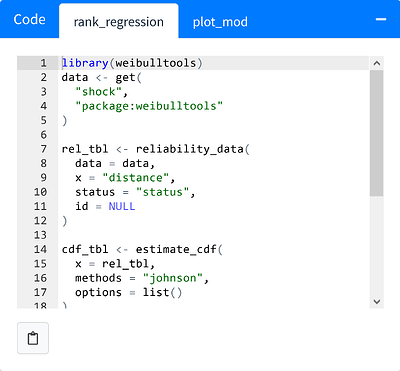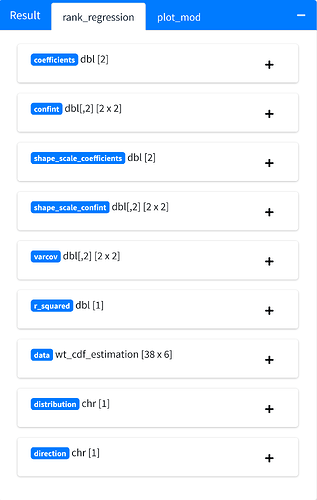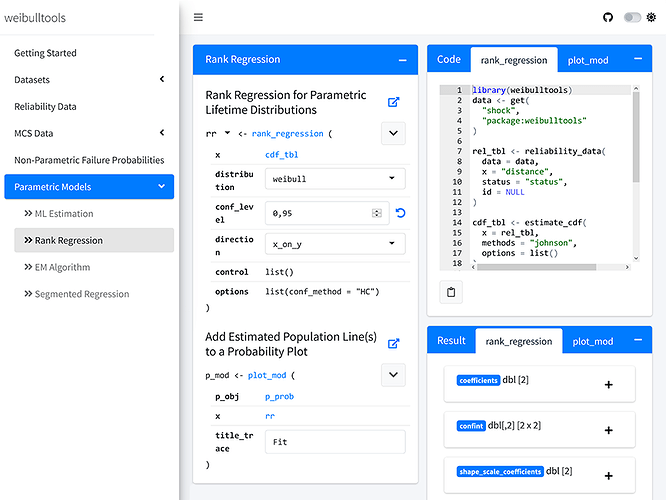{weibulltools} - Interactive Package Documentation
Authors: David Barkemeyer, Tim-Gunnar Hensel
Abstract: The R help and static {pkgdown} websites are well-established locations for learning about a package. This application points out an interactive approach to package documentation. As a proof of concept, the package {weibulltools} is presented.
Full Description:
See also my other contributions:
- myPaintings - Painting Trading Platform - Shiny Contest Submission
- Sensotheka - Management of Inventory, Files & Users - Shiny Contest Submission
- Distributions - Shiny Contest Submission
Overview
The application consists of a Getting Started guide for a quick walkthrough and several tabs which provide more detailed documentation. The user interface of most tabs is divided in two columns.
The left column, which resembles one or more R function calls, is highly interactive.
The following figure shows the components that form a function call.
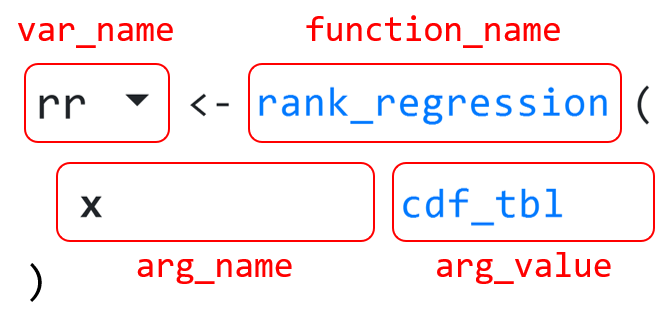
- Clicking on
var_nameopens a dropdown menu which contains links to all locations where this variable is used. Clicking a link switches to the required tab and highlights the function call. - Clicking on
function_nameopens the {pkgdown} page of the corresponding function in a modal dialog. - Hovering over
arg_namedisplays the documentation of the argument (@param) arg_valuemay be either the result (var_name) of a previous function call or a plain argument. In the former case clicking onarg_valuejumps to the location where thevar_namewas defined. In the latter case it is up to the user to choose a value using aselectInputornumericInput.
The right column consists of a code box and a result box. The code box displays the live code which can be used to reproduce the results in an R session. Note that you must have installed the GitHub version of {weibulltools}. The result box displays the result that you get by executing the code of the code box in a user-friendly manner. The user interface depends on the class of the result (table, list or plot). The user interface of a list is recursive, so that nested lists are displayed properly. Code box and result box contain one tab per function call in the left column. Corresponding tabs are connected so that code box and result box always display information regarding the same function call.
Implementation Details
{pkgdown} crawling
The {pkgdown} website of {weibulltools} was downloaded and modified using {xml2}. For example, relative links had to be replaced by absolute links, so that clicking a link in the application leads to a valid {pkgdown} page. {xml2} is further used to extract required information from the html source like the documentation text of each argument or the title of each function.
Code-generation with {shinymeta}
{shinymeta} is an experimental package providing tools for capturing logic in a Shiny app and exposing it as code. It introduces metaReactives, that not only capture results like usual reactives but as well make the code that was used to generate this result accessible. The resulting code is formatted by {styler} and displayed by {shinyAce}.
Lazy-loading of server functions
When the application starts all modules’ server functions are called once. This may give an initial impression to the user that the application is slow when in fact it is not. As this application contains many tabs, it is sufficient to guarantee that only the active tab has been initialized, which is ensured by the logic implemented in container.R, which also handles dependencies between tabs.
Quick fixes
By default, errors in Shiny’s render functions are caught, and a generic message is displayed to the user. Whereas this behavior is desirable when errors occur due to faulty implementation, it is better to display the actual error messages to the user when presenting functions of a package. However, the average application user might not know how to recover from an error. Therefore, quick fix buttons were added, that help the user to recover from the most common errors in {weibulltools}, for example, selecting different distributions for the probability plot and the estimated model.
Miscellaneous
- The dark mode is controlled using a cookie so that the initial state of the dark mode toggle is determined by your previous selection
- Function calls can be collapsed so that arguments are displayed in a shorter, non-interactive manner
{weibulltools}
{weibulltools} focuses on statistical methods and visualizations often used in reliability engineering including the Weibull analysis and Monte Carlo simulations. The Getting Started guide in the application and the vignettes of the {pkgdown} documentation page are great for getting an overview of the package. By providing diverse results like tables, lists and plots, {weibulltools} is especially well-suited to be presented by a Shiny application. The fact that many functions generate results that can be piped to other functions provides unique opportunities for referencing and navigation throughout the application.
- Source code of {weibulltools}: https://github.com/Tim-TU/weibulltools
- {pkdown} documentation page: https://tim-tu.github.io/weibulltools/
- Live version of application: https://weibulltools.org
Keywords: package-documentation, metaprogramming, weibull-analysis, weibulltools, pkgdown, shinymeta, bs4Dash
Shiny app: https://davidbarke.shinyapps.io/weibulltools-app/
Repo: GitHub - DavidBarke/weibulltools-app: Shiny App for R Package weibulltools
RStudio Cloud: Posit Cloud
Thumbnail:
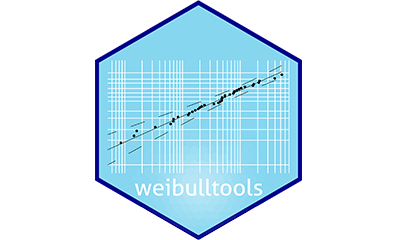
Full image:
